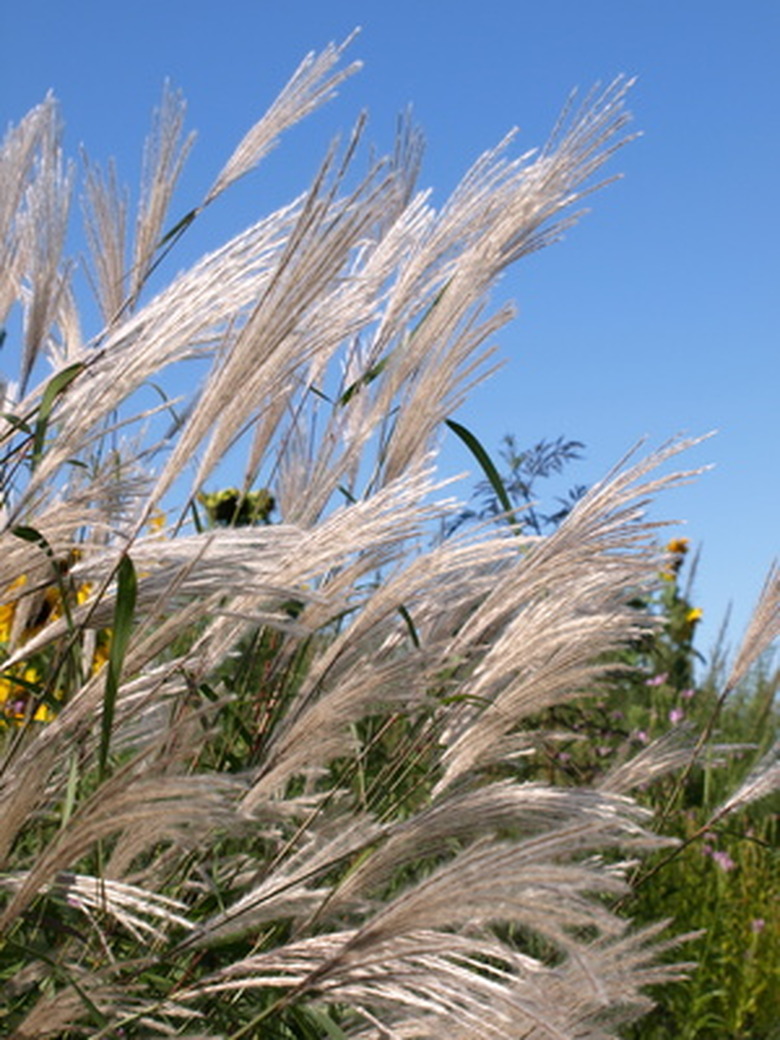Types Of Pampas Grass
Pampas grass is known as the king of the ornamental grasses. Native to South America and New Zealand, more than 24 species of the grass exist, which grows from eight to 12 feet in height. The grass features flowering plumes, in a number of colors, at the end of slender green stems.
Because of its height, pampas grass can be used as a windbreak, an accent plant or as screening in a border or large planting. Plant the grass, which can grow in any type of soil, in full or part sun. The flowers range in color from white to pink and bloom in the fall.
Common Varieties
Pampas grass is known by many names, including silver pampas grass and Uruguayan pampas grass. There are four common varieties of pampas grass planted today, according to "Taylor's Guide to Ornamental Grasses." "Andes Silver" features silvery white plumes and tolerates the cold the best of all types of pampas grass; Gold Band, pampas grass with green and gold leaves; Silver Comet, which has leaves striped with white; and purple pampas grass, which has purple plumes.
- Pampas grass is known as the king of the ornamental grasses.
- The grass features flowering plumes, in a number of colors, at the end of slender green stems.
Dwarf Pampas Grass
Pumila, also known as dwarf pampas grass, grows only to a height of four to six feet, according to "Step-By-Step Ornamental Grasses" by Marsha Jahns. This variety features creamy ivory plumes that are two feet in length and gray green leaves that are up to three feet wide.
Invasive Species
All pampas grass species are considered invasive in California, according to the "Gardener's Desk Reference," by Janet Marinelli. The grass is also considered invasive in South Carolina. Pampas grass was named "Weed of the Week" by the U.S. Forest Service. Gardeners are advised to avoid growing pampas grass in both states.
Kill Pampas Grass
With its low maintenance requirements and ability to grow in areas where other plants cannot, pampas grass can quickly spread and become out of control. It grows between 6 and 10 feet tall in U.S. Department of Agriculture plant hardiness zones 7 through 11. However, with determination it can be done. Forcefully jerk the grass out of the ground. Try to remove the entire root crown to reduce the chance of new plants sprouting. Bag all removed plants — especially the ones that have gone to seed — and send the bag to the landfill. Grasp several pampas grass stalks, bunching them together. Put on a pair of rubber gloves. Spray the cut stalks immediately with a ready-to-use herbicide containing glyphosate as the active ingredient. Repeat the treatment seven days later.
- With its low maintenance requirements and ability to grow in areas where other plants cannot, pampas grass can quickly spread and become out of control.
- Spray the cut stalks immediately with a ready-to-use herbicide containing glyphosate as the active ingredient.
Kill Pampas Grass
With its low maintenance requirements and ability to grow in areas where other plants cannot, pampas grass can quickly spread and become out of control. It grows between 6 and 10 feet tall in U.S. Department of Agriculture plant hardiness zones 7 through 11. However, with determination it can be done. Forcefully jerk the grass out of the ground. Try to remove the entire root crown to reduce the chance of new plants sprouting. Bag all removed plants — especially the ones that have gone to seed — and send the bag to the landfill. Grasp several pampas grass stalks, bunching them together. Put on a pair of rubber gloves. Spray the cut stalks immediately with a ready-to-use herbicide containing glyphosate as the active ingredient. Repeat the treatment seven days later.
- With its low maintenance requirements and ability to grow in areas where other plants cannot, pampas grass can quickly spread and become out of control.
- Spray the cut stalks immediately with a ready-to-use herbicide containing glyphosate as the active ingredient.
References
- Taylor's Guide to Ornamental Grasses; Roger Holmes, ed.; 1997
- Step-By-Step Ornamental Grasses; Marsha Jahns; 1995
- Gardener's Desk Reference; Janet Marinelli; 1998
- Invasive.org
- U.S. Forest Service
- Fine Gardening: Cortaderia Selloana (Pampas Grass)
- Texas AgriLife Extension Service: Grass Control
- University of California Weed Research & Information Center: Pampasgrass and Jubatagrass
- Hawaiian Ecosystems at Risk Project: Pampas Grass
- Fine Gardening: Cortaderia Selloana (Pampas Grass)
- Texas AgriLife Extension Service: Grass Control
- University of California Weed Research & Information Center: Pampasgrass and Jubatagrass
- Hawaiian Ecosystems at Risk Project: Pampas Grass
